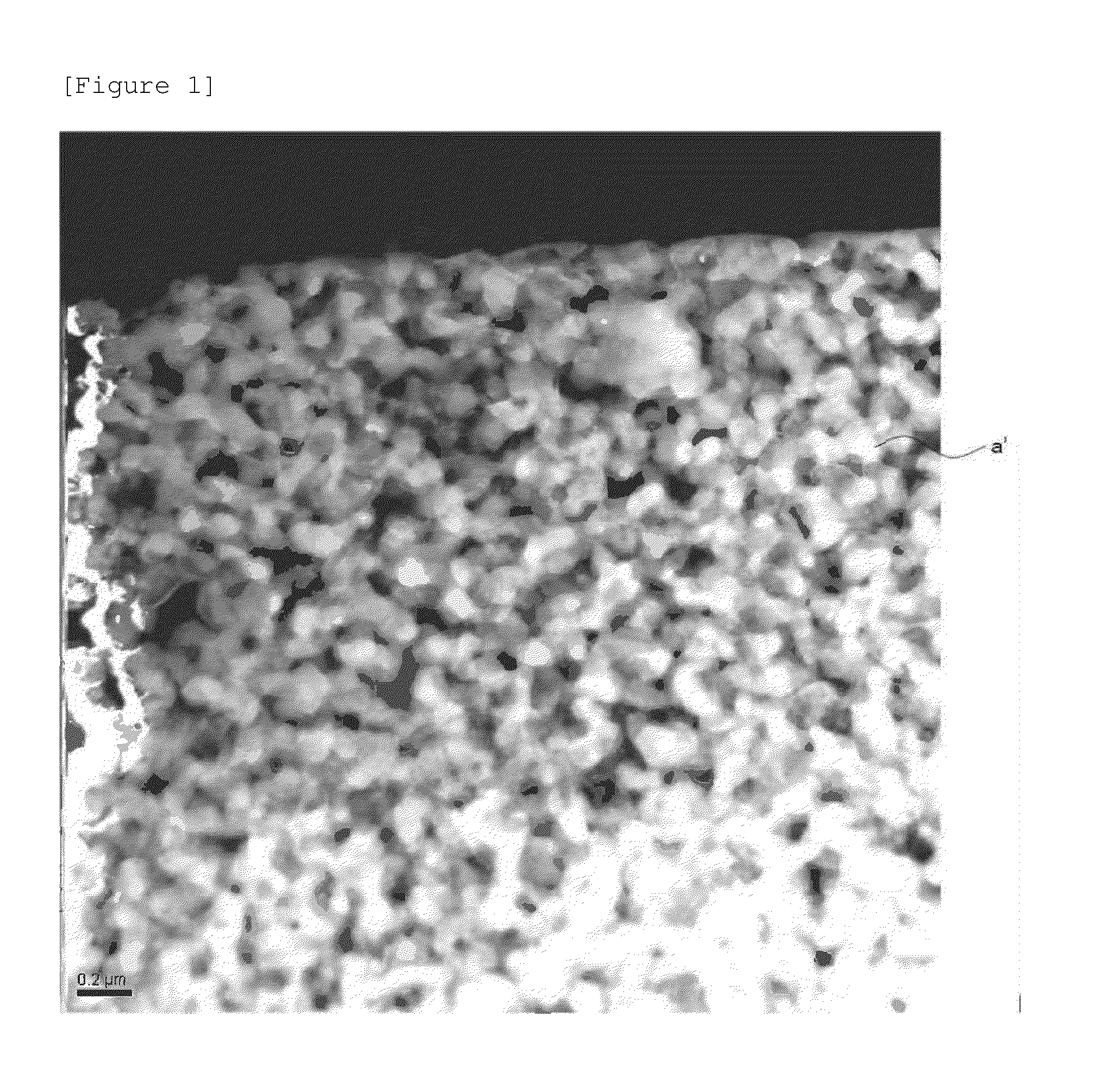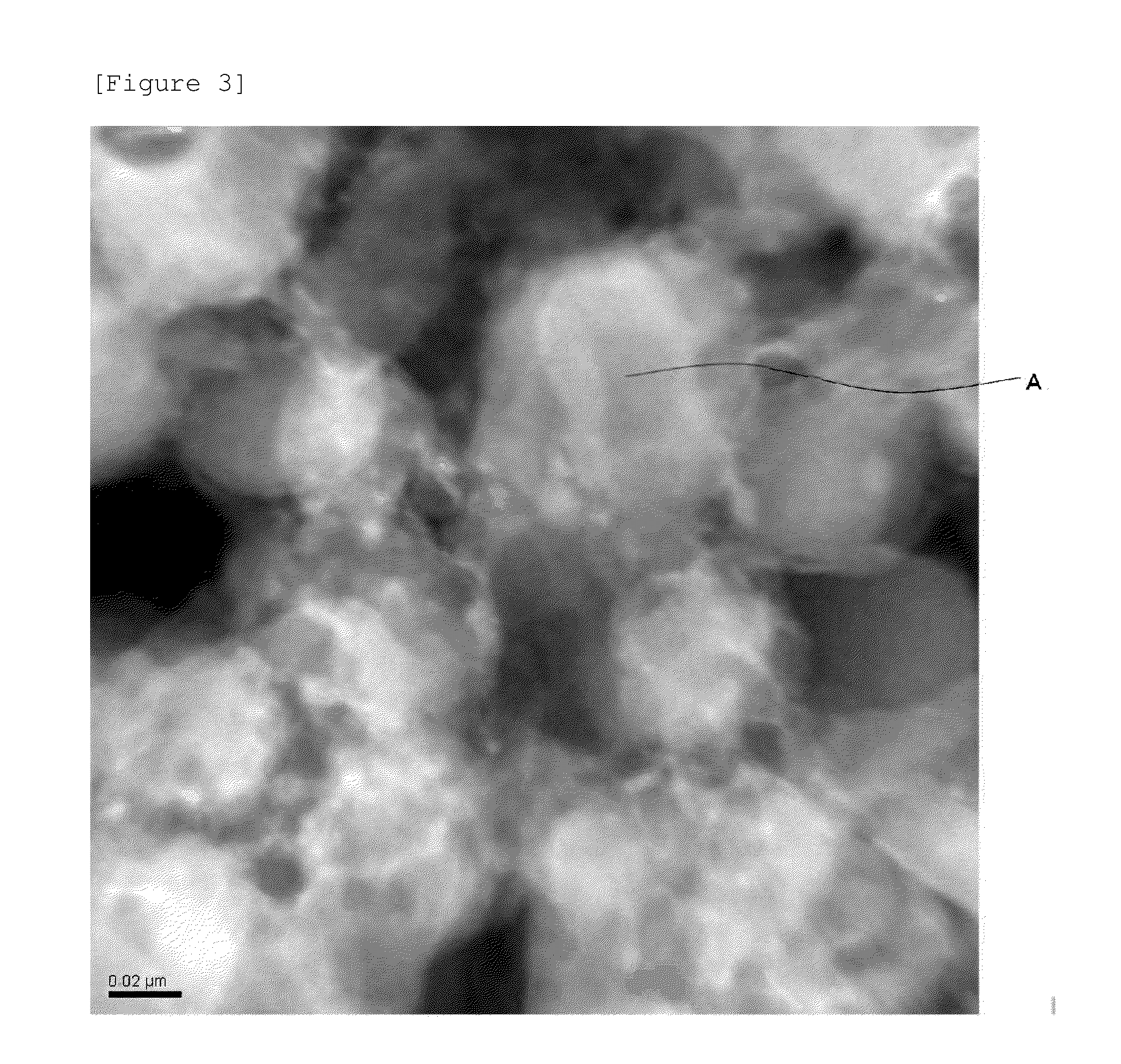Cathode active material, cathode, secondary battery and manufacturing methods for the same
a technology of active materials and secondary batteries, which is applied in the direction of sustainable manufacturing/processing, cell components, silicates, etc., can solve the problems of insufficient consumption power of li ion secondary batteries, inability to meet the performance requirements of mobile devices, and inability to provide sufficient consumption power for recent advanced-function and high-load electronic parts. achieve the effect of facilitating deintercalation and intercalation of li ions, enhancing the diffusivity of li
- Summary
- Abstract
- Description
- Claims
- Application Information
AI Technical Summary
Benefits of technology
Problems solved by technology
Method used
Image
Examples
synthesis example 1
(1-1) Synthesis Example 1
[0076]An apparatus for producing a particulate mixture through a flame method was employed. The apparatus had a reactor having, at the center thereof, a silica rod on which the formed particulate mixture was deposited; a plurality of burners for supplying flame source gases (oxygen and hydrogen) and raw material gases to the surface of the rod, the burners being disposed around the rod; and a discharge tube for discharging non-deposited formed microparticles and reaction products such as hydrochloric acid. The following raw material gases were supplied under the following supply conditions (composition: Li2Mn1-xFexSiO4, target X=0.9):
[0077]H2: 5 dm3 / min,
[0078]O2: 5 dm3 / min,
[0079]LiCl (4M aq. solution): 0.2 dm3 / min,
[0080]FeCl2.4H2O (1M aq. solution): 0.09 dm3 / min,
[0081]MnCl2.4H2O (1M aq. solution): 0.01 dm3 / min, and
[0082]SiCl4: 0.1 dm3 / min.
[0083]Separately, N2 was supplied to the reactor at a specific flow rate, to thereby convert the atmosphere thereof to in...
synthesis example 2
(1-2) Synthesis Example 2
[0084]The same flame method was employed for the following raw material liquids with the following concentrations to be supplied to a propane combustion flame obtained from air and propane gas, for thermal oxidation method, to thereby synthesize and recover particulate mixture b (composition: Li2Mn1-xFexSiO4, target X=0.1):
[0085]Lithium naphthenate (4M solution): 0.2 dm3 / min,
[0086]C16H30FeO4 (2-ethylhexane iron II) (1M solution): 0.01 dm3 / min,
[0087]C16H30MnO4 (2-ethylhexane Mn II) (1M solution): 0.09 dm3 / min, and
[0088]C8H24O4Si4 (octamethylcyclotetrasiloxane) (1M solution): 0.1 dm3 / min.
synthesis example 3
(1-3) Synthesis Example 3
[0089]In Synthesis Example 3, active material r was produced. Specifically, the following raw materials were fed to a pressure container having an inner cylinder made of polytetrafluoroethylene, and the pressure container was placed in an autoclave, where the mixture was allowed to react at 170° C. for 18 hours (hydrothermal synthesis) (composition: Li2Mn1-xFexSiO4, target X=0.5):
[0090]LiOH.H2O: 0.2 mol,
[0091]FeCl2.4H2O: 0.05 mol,
[0092]MnCl2.4H2O: 0.05 mol, and
[0093]SiO2 microparticles (powder): 0.1 mol.
[0094]Separately, a solution of L-ascorbic acid (micro-amount (about 0.01 mol) in ion-exchange water was added to the reaction product so that the total volume was adjusted to 0.5 dm3. The mixture was cooled to room temperature, and the precipitated matter was recovered. The product was sufficiently washed with pure water and then dried under vacuum at 70° C. for 2 hours, to thereby yield active material r.
(1-4) Comparative Synthetic Example 1
[0095]In Compara...
PUM
| Property | Measurement | Unit |
|---|---|---|
| crystallite size | aaaaa | aaaaa |
| particle size | aaaaa | aaaaa |
| particle size | aaaaa | aaaaa |
Abstract
Description
Claims
Application Information
 Login to View More
Login to View More - R&D
- Intellectual Property
- Life Sciences
- Materials
- Tech Scout
- Unparalleled Data Quality
- Higher Quality Content
- 60% Fewer Hallucinations
Browse by: Latest US Patents, China's latest patents, Technical Efficacy Thesaurus, Application Domain, Technology Topic, Popular Technical Reports.
© 2025 PatSnap. All rights reserved.Legal|Privacy policy|Modern Slavery Act Transparency Statement|Sitemap|About US| Contact US: help@patsnap.com



